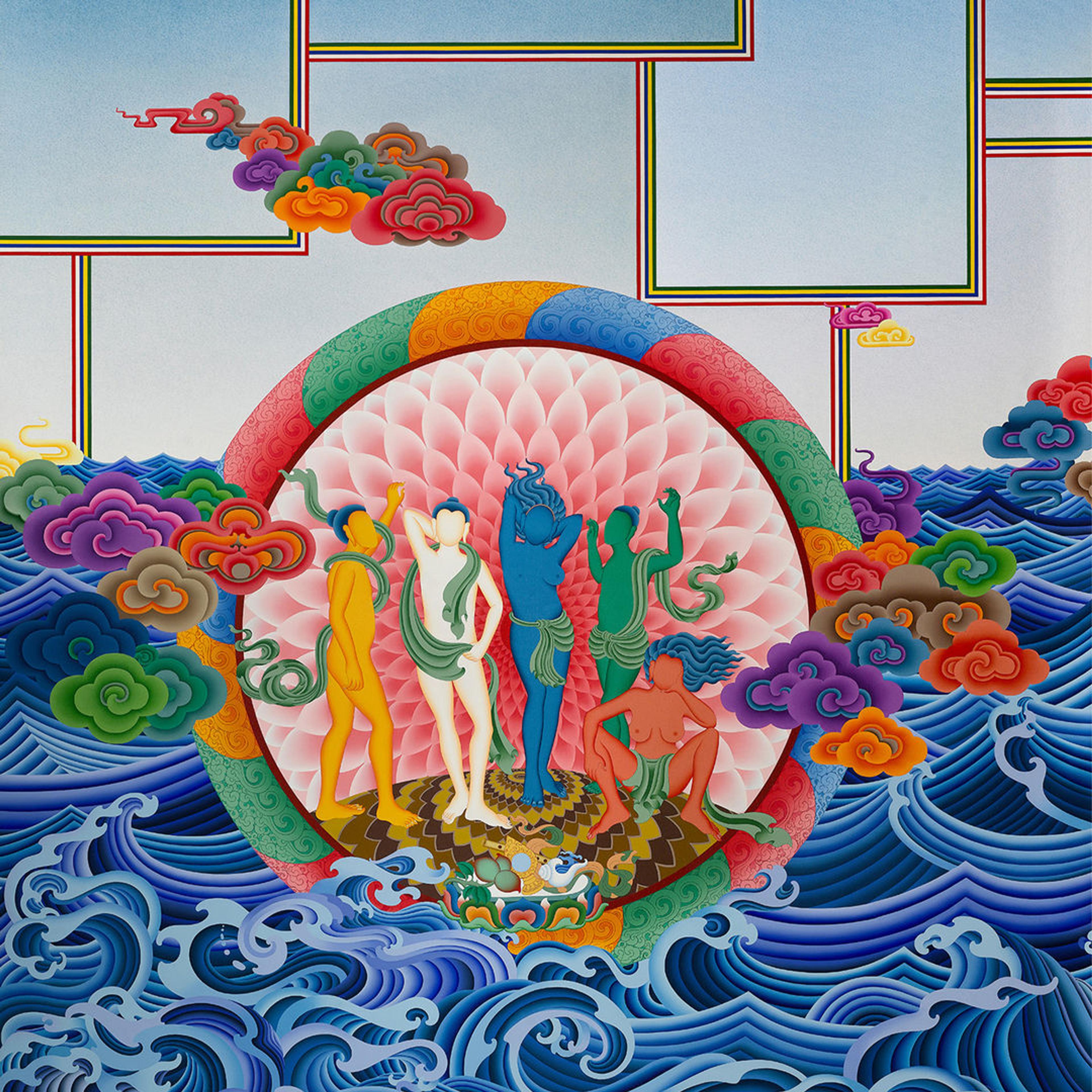Tenzing Rigdol was born in 1982 in Kathmandu, Nepal, after his Tibetan parents, Norbu Wangdu and Dolma Tsering, fled occupied Tibet in the late 1960s. Rigdol came to the United States in the late 1990s to study at the University of Colorado Denver, earning a BFA in painting and drawing and a BA in art history in 2005. During this same period, he also studied traditional Tibetan sand painting and butter sculpture at the Shekar Chorten monastery in India and thangka painting under Phenpo Tenthar at the Tibetan Thangka Art School in Kathmandu.
Rigdol is one of several Tibetan and Nepalese artists who have found significant success on the global contemporary art stage in recent years.[1] While the artistic production of this group is diverse, Rigdol and a handful of others initiated the practice of recontextualizing early motifs, styles, and ideas from the classical Himalayan canon to comment on a range of social and political issues. This opened the door to recasting earlier Buddhist imagery to convey secular ideas and to consider Buddhist values in today’s society. In 2015, he established the Khanyara artist residency in Dharamshala, to support emerging artists in exile and to foster exchange and collaboration within this community.
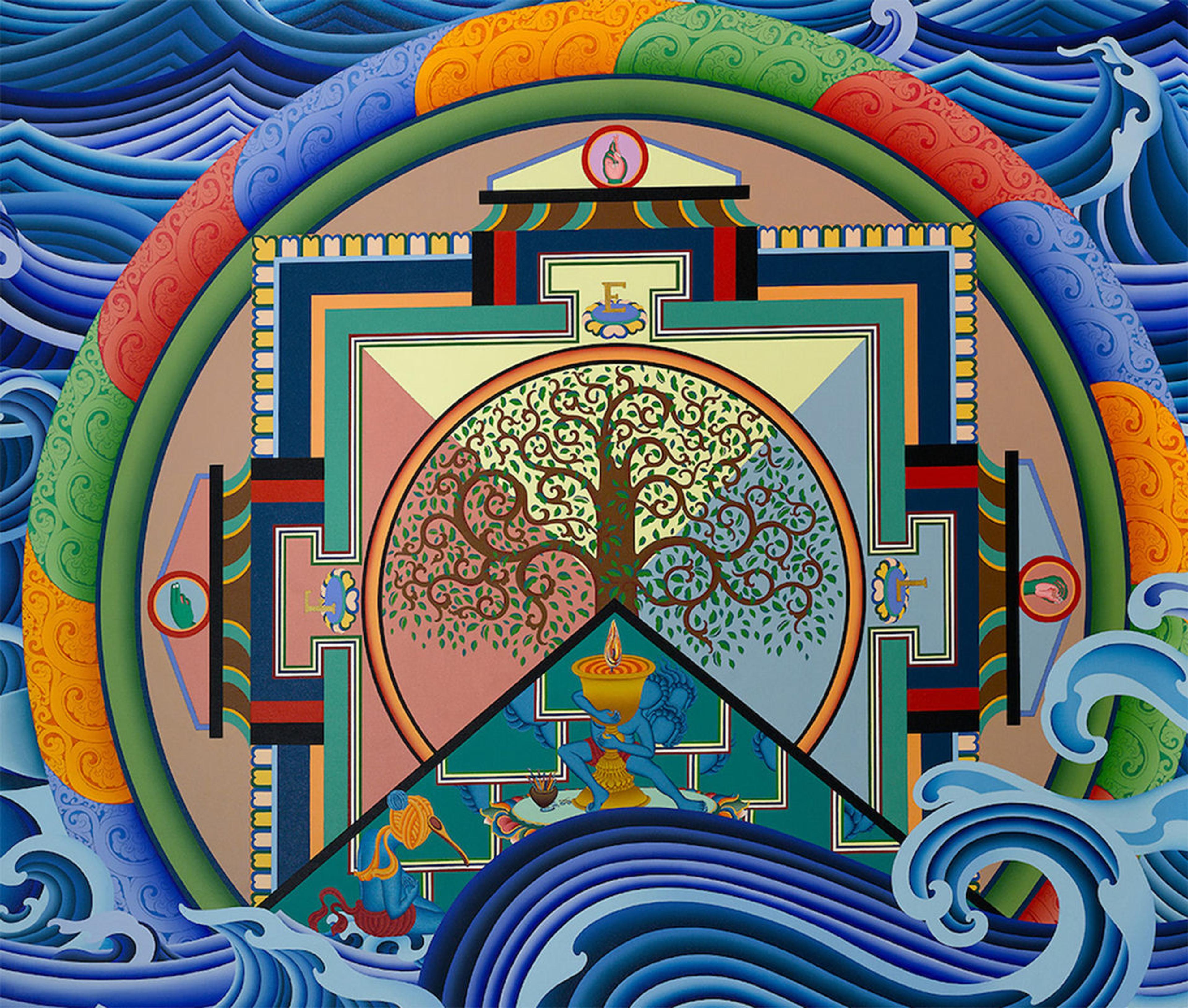
Detail of Tenzing Rigdol’s Biography of a Thought showing a mandala with a tree amid waves
In acknowledgment of how Rigdol’s work traverses the traditional and the contemporary, as well as geographic and cultural boundaries, I invited him to participate in Mandalas: Mapping the Buddhist Art of Tibet by creating a site-specific installation at The Met. His work complements and helps contextualize the historical material that forms the majority of the exhibition. The piece, like all of Rigdol’s work, approaches Buddhism in multipronged ways and embraces core tenets such as mindfulness, or living in the present moment. Equally, using tantric or esoteric Buddhist ideas to structure his artistic presentation is critical to Rigdol’s process in terms of the viewer’s ability to understand the mechanism of thought. The title of the work, Biography of a Thought, hints at the tantric idea of taking a notion and untangling its myriad components, then visually representing these constituent parts to achieve deeper insight.
Still, the artist is adamant that his work, with its social and political content, is secular, despite employing charged motifs and iconography from the Buddhist canon, such as the mandala, to frame complex ideas. For this reason, the many eleventh- to fifteenth-century works in the surrounding galleries provide a foundation for understanding the subtle content of his installation.
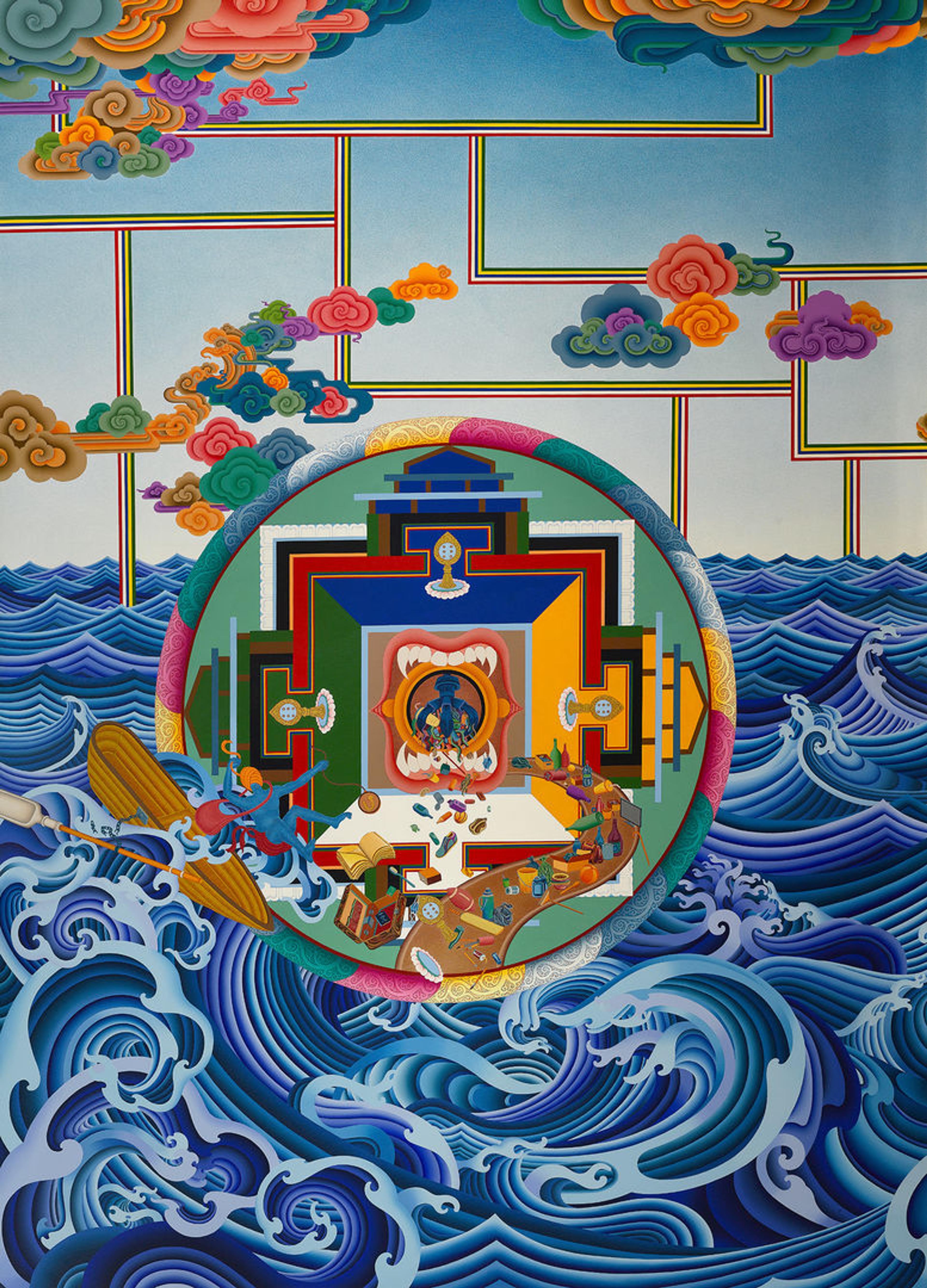
Detail of Tenzing Rigdol’s Biography of a Thought of a mandala containing an individual tossed from a boat and an open mouth spewing trash
Biography of a Thought also draws on a body of personal iconography, which pervades the installation. For example, the red linework evokes the plans followed by weavers when making carpets, a practice the artist’s family was engaged with in Nepal after they fled Tibet as refugees. In this context, the handwoven carpet that unifies the installation—its composition employs lotuses as a reflection of the many mandalas seen in the wall paintings—comes out of this deep personal history. As Rigdol explains:
You will find throughout the paintings a miniature figure with
his head wrapped. The figure represents “me,” wherein the
wrapped head symbolizes my awareness about my limited knowledge
and ignorance. In the first painting, you can see the individual being
thrown into the world with the boat—a very existential approach.
Indeed, being cast into this world and struggling to overcome ignorance are both Buddhist concepts, as is the idea embodied in the associated mandala evoking sound as the ultimate, cosmic source of all things, here shown as an open mouth.
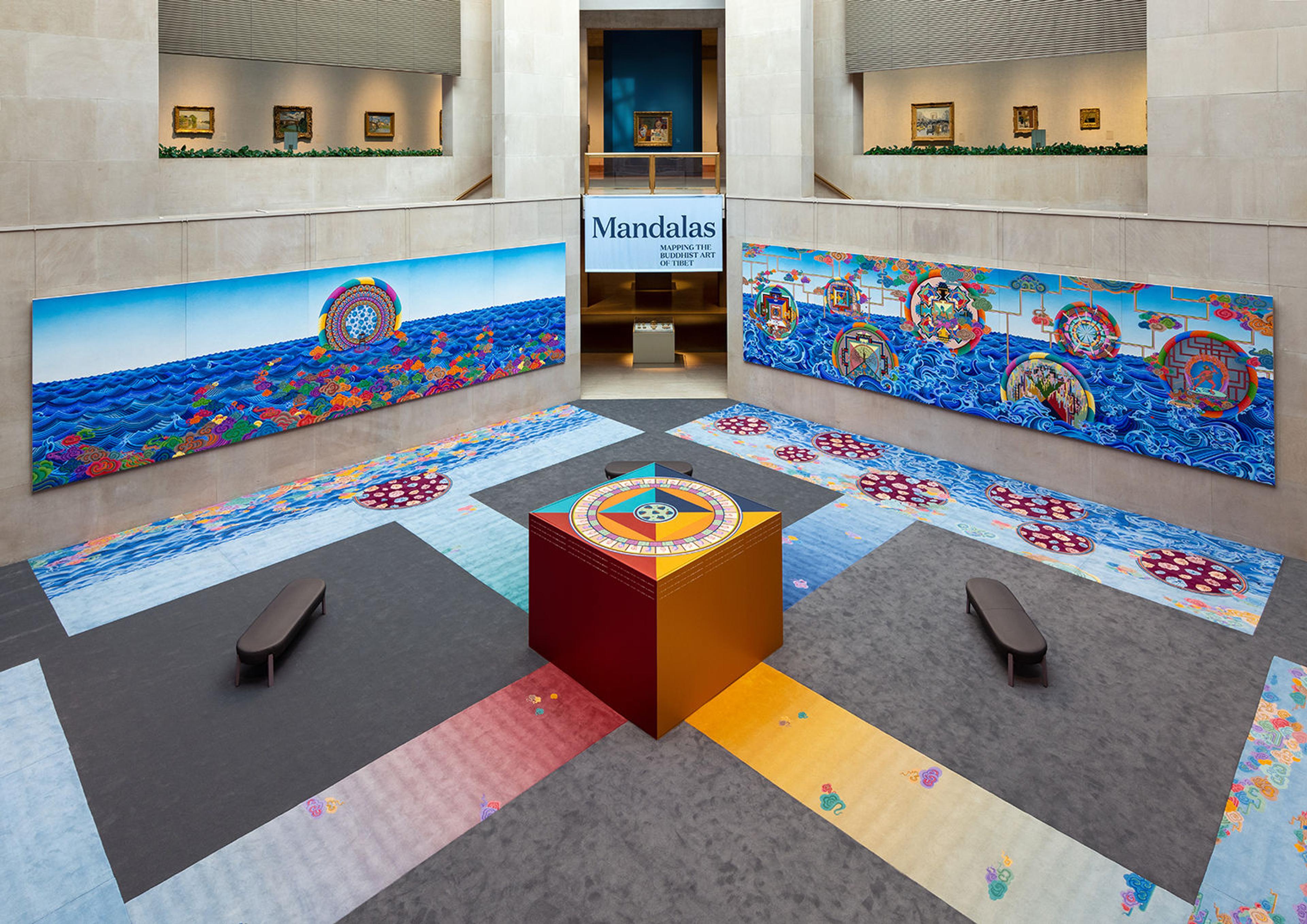
Tenzing Rigdol, Biography of a Thought, general view of the gallery and handwoven carpet.
At the same time, Rigdol uses other imagery—a construction crane, trash, smokestacks—that we can immediately read as a comment on environmental pollution. It exemplifies how his work has many levels of embedded symbolism. The very idea of discovering underlying meaning is integral to tantric art, but Rigdol utilizes symbolism accessible to a modern audience. At the same time, throughout the installation, he has integrated elements of American Sign Language, which he calls “ASL mudras,” related to classical deities or specific ideologies. Only those who know ASL can readily interpret the meaning of these mudras. Equally, he has embedded into the work poetry written in braille, which again is meant to be legible only to those familiar with this system of reading. Thus, while the installation overall is directed at a contemporary audience, by limiting access to certain parts of it to those who can understand braille or ASL, it aligns with tantric ideas of revealed deeper meanings that can only be discerned by someone with special training and knowledge. One could, however, also note that the incorporation of ASL and braille serves to reach across lines demarcated by disability and language, reflecting Rigdol’s self-professed desire to communicate as a human “without belonging to any nation, race, class, group, tribe, club, or creed." [2]
In conversations, Rigdol and I were able to share and to question, conceptually, how contemporary and ancient expressions relate and how a fusion of these ideas might be explored. What follows is an edited and condensed version of our conversations, which occurred throughout the creation of Biography of a Thought.
Kurt Behrendt:
How did the process of making this massive artwork impact your thinking?
Tenzing Rigdol:
When you showed me the space, [the skylit galleries of The Met’s Robert Lehman Wing,] there was really no beginning and end. It was a mandala in itself. The artworks are installed on four big walls, and you can read the painting from whatever angle you want. On each wall, you see five panels of paintings that are mirrored in a carpet [at the center of the space, where the viewer can sit]. It is like we ourselves are in the ocean of ideas. There is a sequence in the sense that there is a beginning and there is an end, where one can enter from any point. The first wall deals with our behavior and our ecosystem; the second and third walls try to celebrate [and] explore great ideas about virtue, beauty, and peace. Then, the fourth panel hopes to capture silence, calmness, or stillness. There is also a central piece uniting the whole which talks about the idea of interdependence.
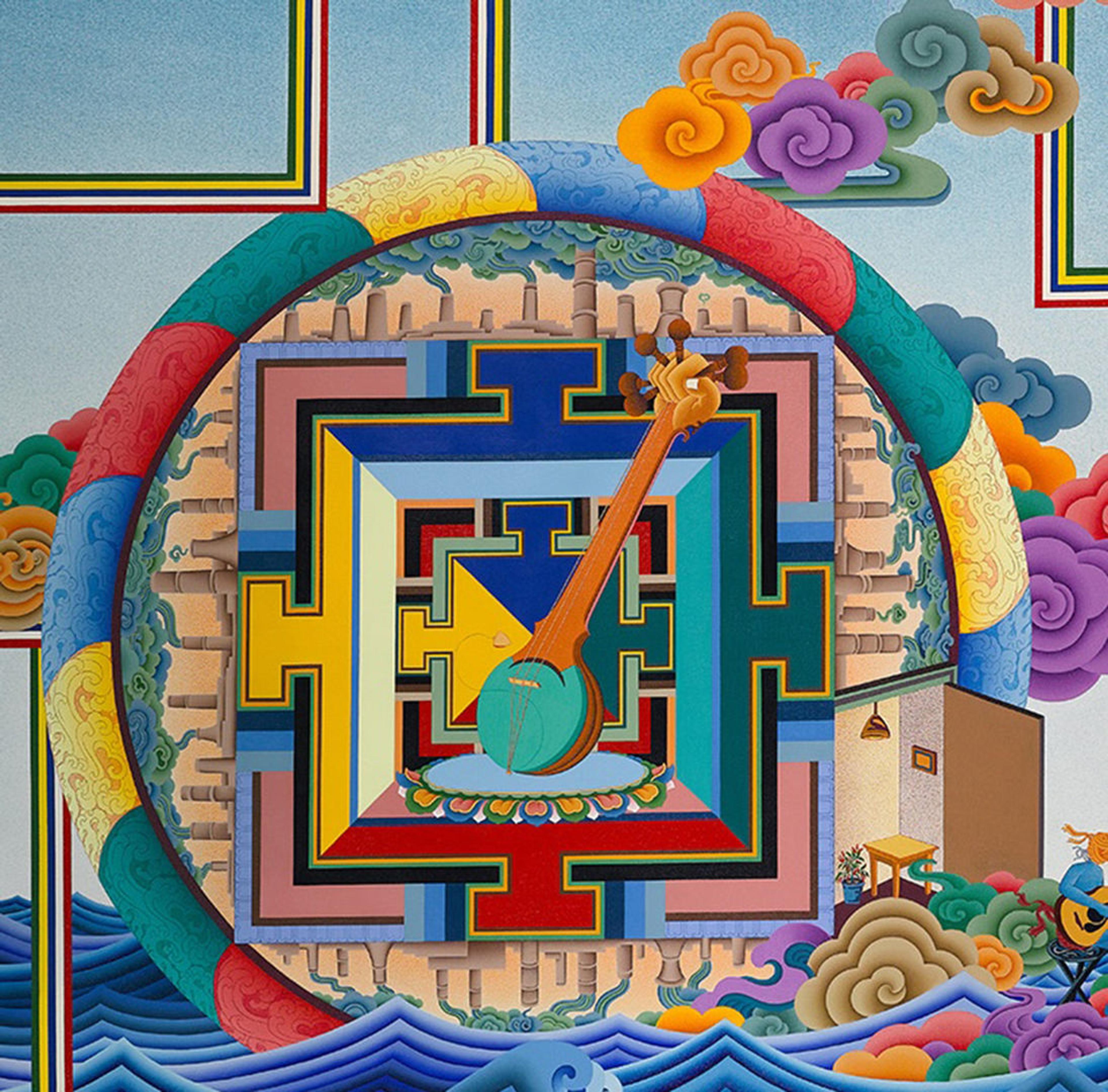
Detail of Tenzing Rigdol’s Biography of a Thought of a mandala showing a self-tuning lute surrounded by smoke stacks
The intention behind the installation as a whole is to explore the content of Biography of a Thought. It is about a journey of a single thought that gathers momentum and produces many thoughts, which in turn cluster and become ideas, and these ideas start changing people’s lives. In this series of works, I see vibrant thoughts as clouds and feel volatile emotions as waves, and in between we have what I call the mandalas of our time. The churning ocean, the clouds, and the structured grid unify the four walls and set the stage for the twenty-three mandalas that emerge from this environment. The tree explores issues of air quality and pollution. The second mandala explores self-transformation as expressed through a self-tuning lute. The whole relates to our responsibility for violence directed at our own environment.
Behrendt:
The core root of human conflict lies in how thoughts are constructed. The first wall of the installation addresses our world, while the second is about unstable thoughts, which create conflict among humans.
Rigdol:
I am talking about the human relationship between thoughts and violence. As an individual, throughout my learning process, I found and I still find certain issues quite powerful, shocking, or unsettling. The artworks reflect upon war, colonialism, racism, gun violence, terrorism, and how they are all a product of turbulent thoughts.
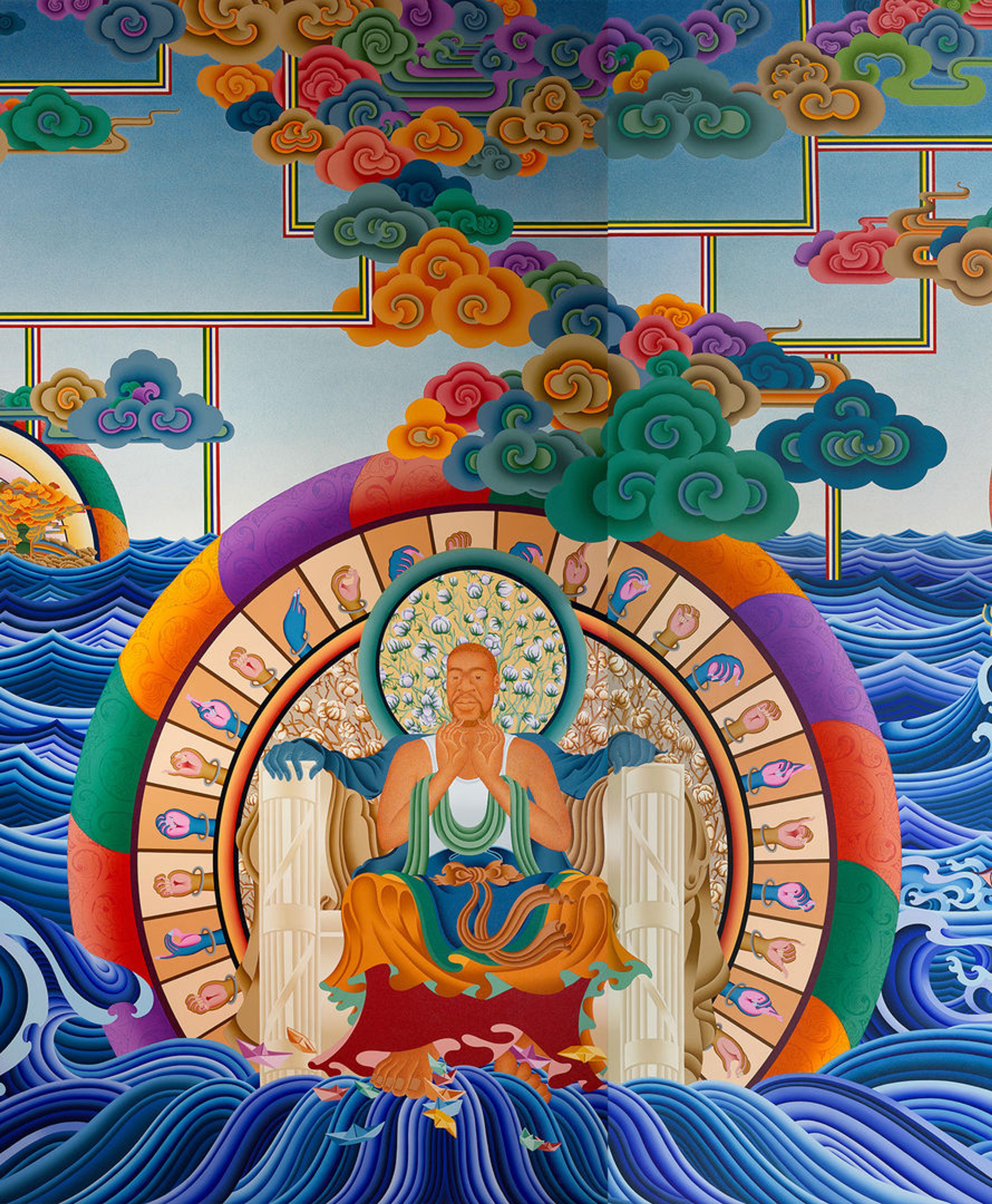
Detail of Tenzing Rigdol’s Biography of a Thought showing George Floyd
Racism being one of the most debated and discussed issues in the United States, I couldn’t help but depict George Floyd, [the unarmed Black man who was murdered by police in Minneapolis in 2020,] in a form of Maitreya, the friendly future Buddha, behind whom the aura of the tragic past lingers. ASL mudras run along the edges of the mandala, which read prosperity, hope, and desire—three early ships built in America to bring slaves. I believe that confronting truth with a brave and warm heart is a way forward. We can transcend from inheriting pain and suffering to inheriting wisdom and love.
Behrendt:
In the center of this wall is a complex image of the tantric deity Kalachakra. How does this figure relate to the core ideas of this section?
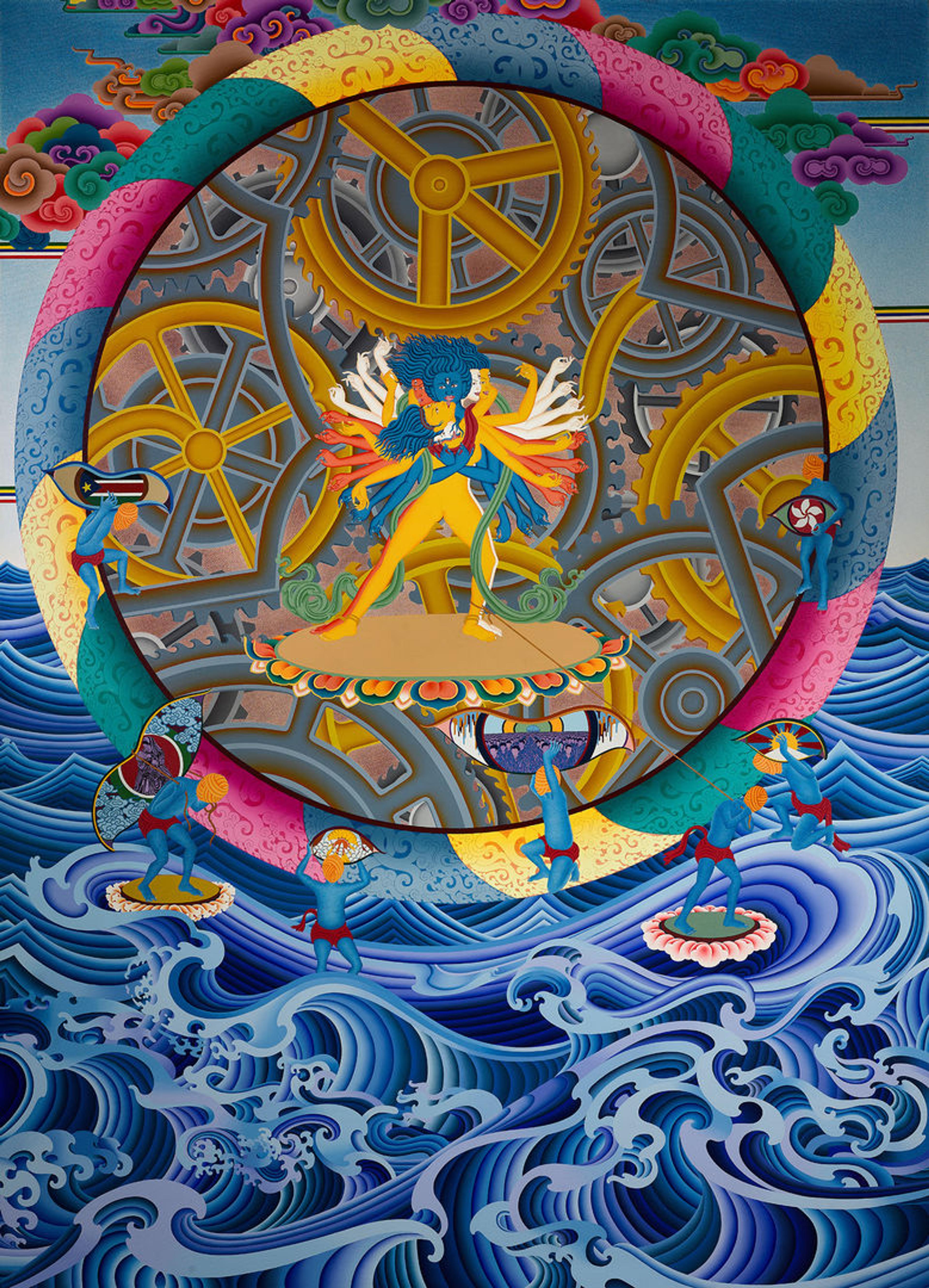
Detail of Tenzing Rigdol’s Biography of a Thought showing Kalachakra mandala
Rigdol:
The central panel expresses the complex wheel of time. The Kalachakra Tantra is considered Buddha’s last tantric teaching, wherein he revealed the subtle relationship of breath to thought, then thought to time, then time to motion, then motion to suffering, and then suffering to thought. Therefore, it is interesting to me as an artist to imagine a composition that expresses both the sense of motion and non-motion. In the painting I depict the Kalachakra deities against the mechanism of time, with miniature figures ushering awareness toward collective human suffering.
Behrendt:
On the next wall, you mention that the idea was to address paradigmatic ideas that shape or govern our world.
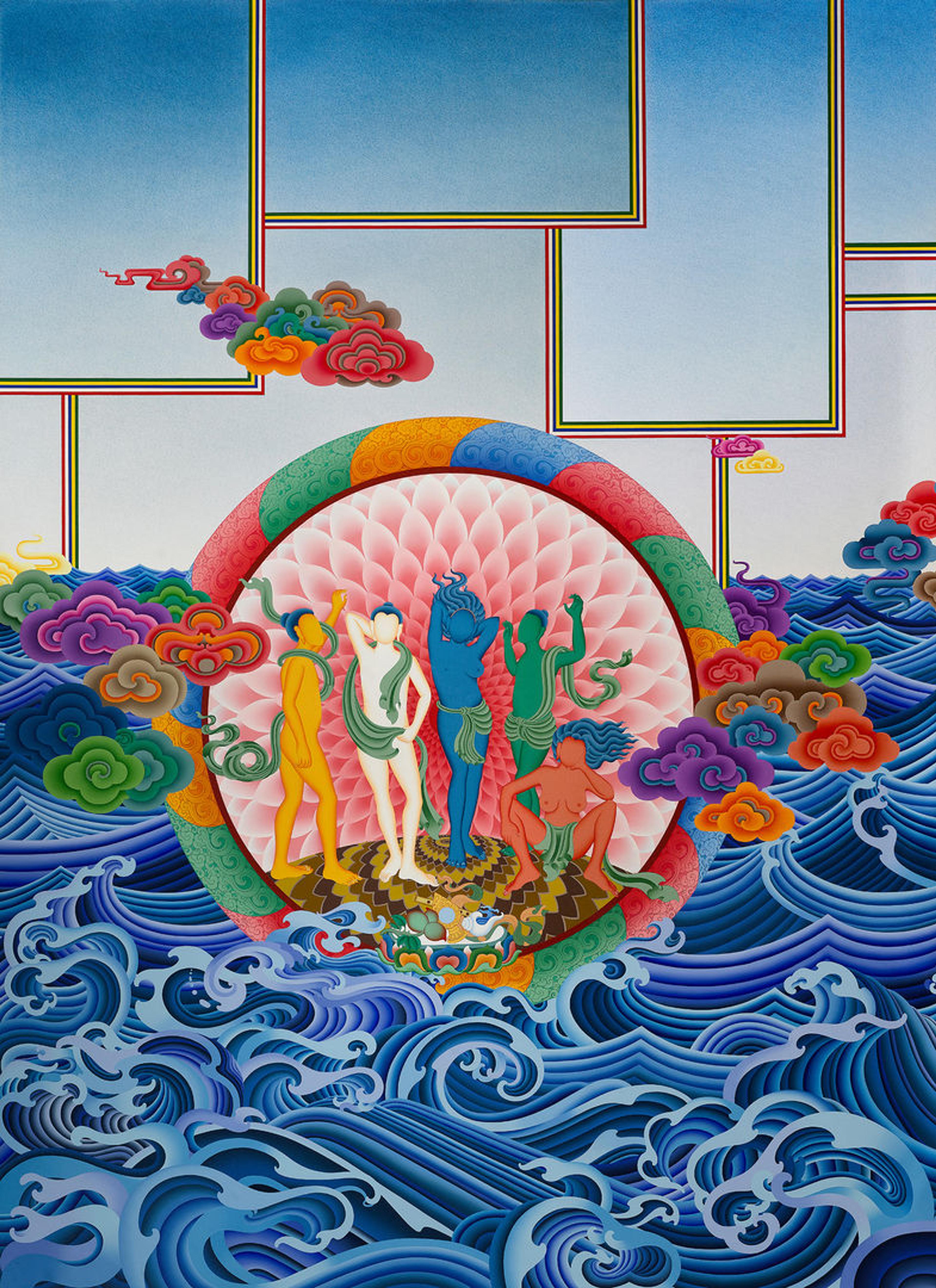
Detail of Tenzing Rigdol’s Biography of a Thought of a Mandala showing an interpretation of Picasso’s Les Demoiselles d’Avignon.
Rigdol:
I start the third wall by subtly poking at Picasso’s painting Les Demoiselles d’Avignon. In the scene he has depicted five women from a brothel. It is considered one of the most important artworks of the West, and I also love the work. However, I reconstruct them and give them a new form, along with a new status. I also turned Picasso’s famous scene into the symbolic Buddhist offerings of the five sensory faculties. In tantric texts, they say if you can have a proper understanding of all five of your mental faculties—sound, touch, sight, taste, and smell, represented below the figures—then you immediately realize that you are not male or female or any gender; you are just pure awareness. One of the core messages of Tantra is that you are much more than just your body and mind.
In an adjacent mandala are figures of recent whistleblowers who have drawn the world’s attention to issues such as government surveillance of private citizens and the surreptitious mining of our personal data by certain tech companies], such as Frances Haugen, Chelsea Manning, Edward Snowden, and Julian Assange. I’m talking about how, in our present-day life, we are surrounded by digital media, with everybody trying to collect data. Individuals are even discussing whether this whole world is a simulation or not. That’s been happening in the East for thousands of years, where even the Buddha himself says, “I am Buddha,” meaning, I am awake, I have woken out of a simulation, and he says, “You guys are in a dream state.”
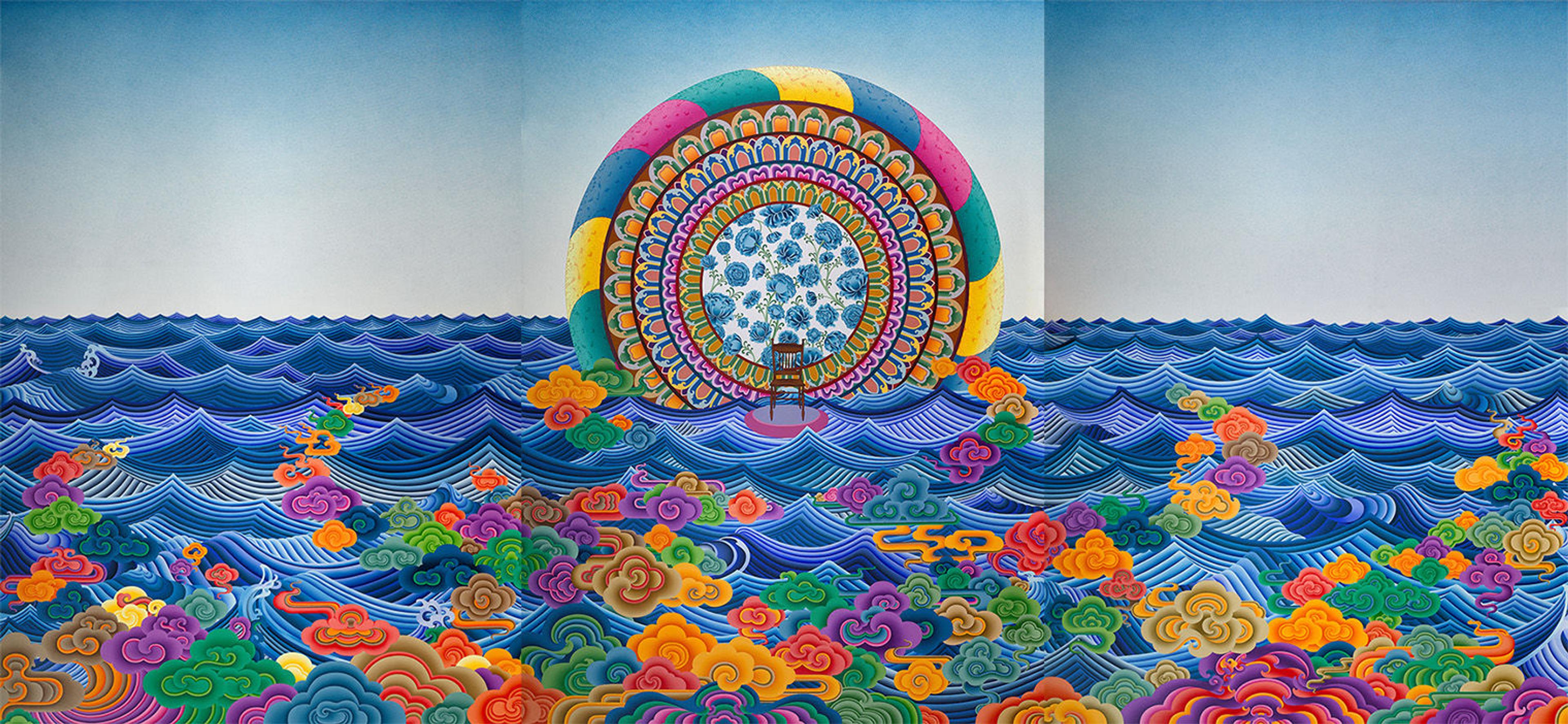
Tenzing Rigdol (born Kathmandu 1982). Biography of a Thought, 2022–24. Acrylic on woven carpet, H. 40 ft. (1219.5 cm); W. 40 ft. (1219.5 cm). The Metropolitan Museum of Art, New York, Collection of the artist
Behrendt:
There is so much more that we could talk about regarding the mandalas and the last wall related to the idea of, as you put it, “silence or calmness or stillness.”
Rigdol:
The thoughts—the explosive clouds—that run across every frame on every wall decant and settle on this final wall. The central piece of the final wall is a dignified, empty chair behind which a poem in ASL mudra reads:
A thought is a painting, a design, a composition.
A thought is a breath, a line, a dot without the edges.
A thought is a melody, always strumming on instruments,
With or without the listener.
Behrendt:
Then there is the central image—the core of the mandala. How does it relate to all that surrounds?
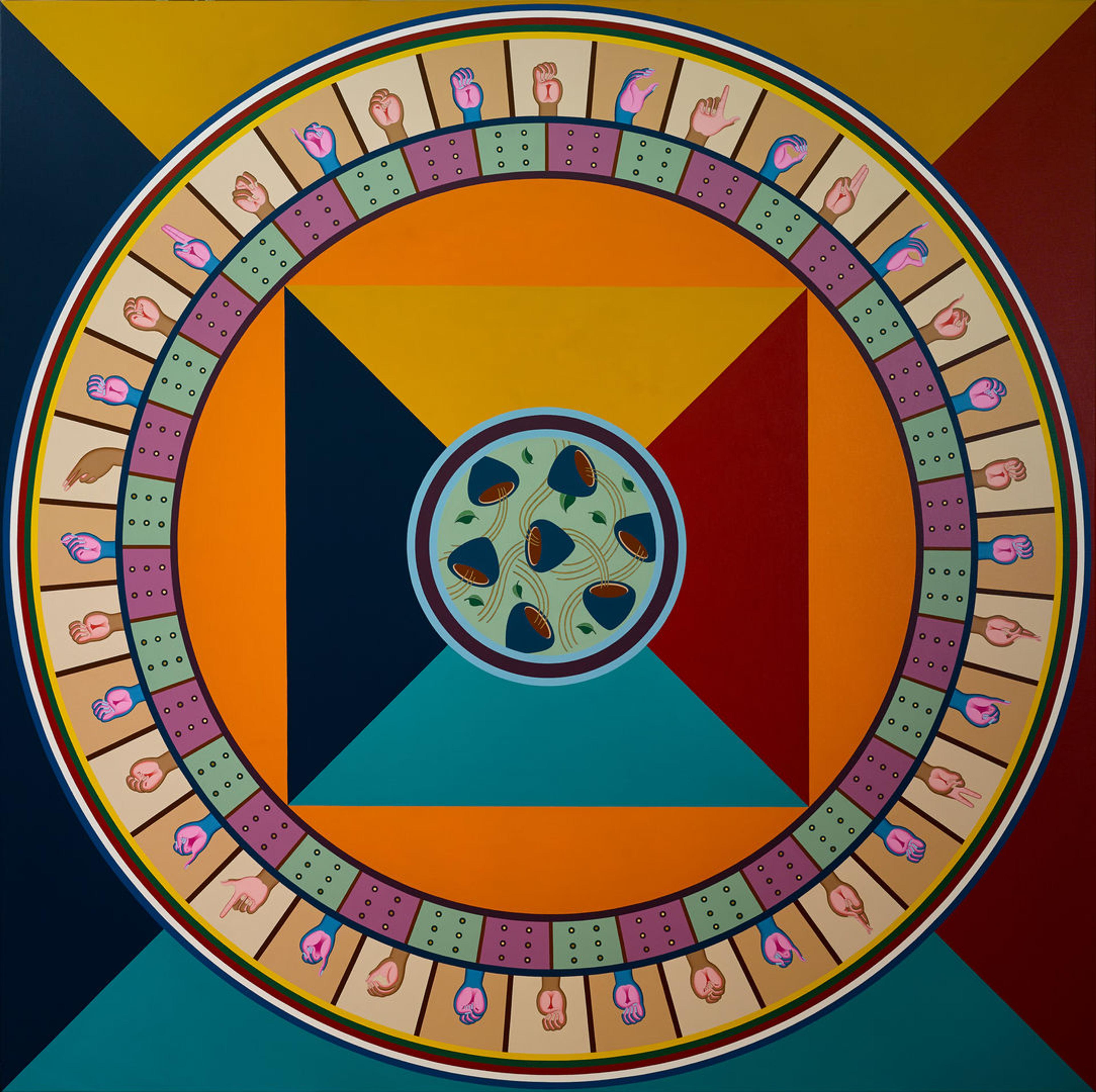
Detail of Tenzing Rigdol’s Biography of a Thought showing central panel focused on interdependency
Rigdol:
On the central panel, I’m trying to explore the quintessential tantric idea of universality and oneness and how intricately interconnected we all are. It is said that when the Buddha reached enlightenment, he looked at a leaf, and on that leaf he saw stars, he saw rain, he saw soil, he saw air, and, in essence, he saw interdependency. He saw how we are all interconnected at a much deeper and profound level. It’s really celebrating how we all have the power of being interdependent; that is a very powerful thing. So the central piece becomes something hopeful.
Behrendt:
The actual creation of this work has been quite an undertaking. From the outset, you have been very deliberate. For instance, I know you enjoyed focusing on the unique characteristics of each wave drawn from direct observation in New York, or the clouds based on numerous photos taken in Santa Fe, New Mexico.
Rigdol:
If I really believe in process, then I can believe in the painting because it does something. The paradoxical thing is that, every time I paint, if my mind goes to our exhibition, then I look at myself in a mirror, and I scold myself: “Shame on you, you’re going to the future.” This is one of the fundamentals of my practice. Art is really about understanding yourself and improving yourself. Once I put all the pieces together, I was, like, wow, it looks quite alive, it’s breathing.
Behrendt:
In terms of the creation of this work, you have had to structure it to conform to and accommodate the specifications of the space—for instance, in the use of acrylic paints that can take high levels of ultraviolet light. Starting with preliminary drawings, I have watched your work transform and come into focus. These drawings were in turn transferred to the canvases. In terms of materials, you sourced handwoven canvases from Nepal. You also designed a carpet that is mandalic in its conception, which was handwoven in Kathmandu. What are your feelings about such a sustained and complex artwork?

Two images of Tenzing Rigdol working on Biography of a Thought
Rigdol:
The study of the core composition took me about two and a half years, and then about three more years to complete. This is my biggest composition thus far, and I hope that viewers will find it interesting in their own ways. To create the paintings, I needed a big studio with two or three forty-foot-long walls and, at least, eleven-foot-tall ceilings. However, I couldn’t find such space in Kathmandu, so I had to create a studio on the roof of a building. I found a very generous and kind man named Neljo Gurung who made a studio according to our needs, which helped tremendously. I told him I wanted the studio to have horseshoe-shaped windows, an inverse design of an arched Ajanta cave, running through the three consecutive walls so I could get as much light as possible. The entire work is done almost entirely under bright natural sunlight.
Behrendt:
I know that you are working with a group of local painters to help execute elements of the installation, especially the clouds, sky, and waves. Working with a team has allowed you to apply a stippling technique, which gives these features volume and dimension but is a time-consuming, detailed process.
Rigdol:
All my assistants are of various backgrounds. For the first six months, I did a lot of studies on color and focused on training the assistants. They are all wonderful, talented individuals, and I have come to know them and their families. I am grateful for their kind assistance, and I must also say that this work would not have been possible without the support of my mother and my wife. What I genuinely love about such a large-scale, multifaceted project is that I got to know and befriend individuals from various backgrounds, and I learned a lot more about this grand process called life.
This interview is adapted from the catalogue for the exhibition Mandalas: Mapping the Buddhist Art of Tibet on view through January 12, 2025
Notes
[1] For more on Tenzing Rigdol and other contemporary artists from Nepal and Tibet, see Harris 1999; Magnatta 2019.
[2] Tenzing Rigdol, interview with Kurt Behrendt, fall 2023.
